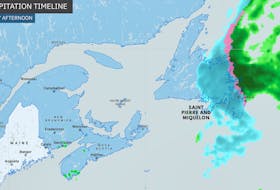On April 17, the weather map looked like the inside of a crayon box: so many colours!

The various colours defining the numerous weather warnings, stretched from one end of Atlantic Canada to the other. While the weather was less than lovely in Halifax, there were no warnings in place for Nova Scotia’s capitol city. At about 1:30 p.m., just as the skies were opening up, Kathleen MacEachern tweeted: “Cindy, I’m wondering why there are no rainfall warnings for Halifax? A lot of streets have become puddles”.
I have to start by saying that only our national weather service, Environment Canada, has the authority to issue weather warnings.
In the case of rainfall warnings, three things must be taken into account: season, amount and duration.
Winter rainfall warnings are issued when at least 25 mm of rain is expected within 24 hours. That number varies regionally. For example, for British Columbia, a winter rainfall warning is issued when 50 or more mm of rain is expected in 24 hours. Those numbers change for summer warnings, too. In the summer, it takes 50 mm of rain in less than 24 hours for a warning to be issued in Atlantic Canada.
Then, there’s “short duration” rainfall - we call them downpours. In Atlantic Canada, a warning is issued when 25 mm of rainfall is expected in less than an hour. This type of intense rain is usually associated with convective weather, like thundershowers.
Yesterday’s rainfall fell just under the 50 mm in 24 hour limit, but, just before 1:30 p.m., when the rain was teeming as Grandma would say, you could have made a case for a rainfall warning.
The question of when warnings are issued is one that often comes up. Warnings can be issued up to 24 hours before the “weather” starts in your area. That’s why you often see warnings appear from west to east as a system moves forward.
Every day we hear, see or read the weather, but understanding the weather forecasts will give you a leg up on the next guy - and might even keep you dry!
- Want more weather information? Visit WeatherByDay.ca
- Have a weather question, photo or drawing to share with Cindy Day? Email [email protected]
Cindy Day is the chief meteorologist for SaltWire Network.









